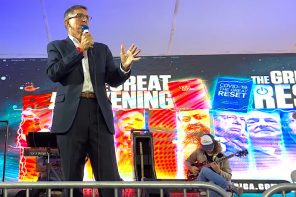According to popular understanding, the Maya apocalypse is set for December 21. And despite the fact that only 2% of Americans actually believe that the world will end tomorrow, there has been a significant uptick in searches for one-way flights to airports near towns in the South of France and Turkey (both of which are rumored to be safe havens from the apocalypse), so everyone from scholars to journalists to NASA—even the Vatican—continue to quell worries and debunk myths.
Well before we began to approach the actual date, the Maya apocalypse hysteria inspired Mark Van Stone, an expert in Mayan hieroglyphics, to write 2012: Science and Prophecy of the Ancient Maya (Tlacaelel Press, 2010), which reveals what the Maya actually believed about this end-of-days scenario.
Religion Dispatches recently caught up with the highly sought after Van Stone to see what all the hubbub is about—and to get some answers.
According to believers, how will the Maya apocalypse go down?
Two of the more common ideas are that the world will end in a puff of smoke or that some rogue planet meteor will hit us, while others believe that our world will simply be lifted up into a higher plane of consciousness.
There are still others who believe that the poles will shift. Or, that there will be a solar storm of destruction. And then there is this notion that the planets are going to align; though December 21, 2012 is winter solstice and there is nothing apocalyptically significant about that phenomenon.
There are also people who believe that spacemen helped the Maya, and they back up these theories by saying the Maya couldn’t have been capable of building what they built. All they are saying is that they are incapable of imaging themselves accomplishing something like what the Maya had accomplished. It represents a vast failure of imagination. It is racism against the human race.
Tell us how December 21, 2012 came to be the dreaded Maya apocalypse in the first place.
The Maya have a long-count calendar, which counts the days that existed before our world, when the gods ruled, followed by the days since the creation of our world.
The gods’ world lasted 5,125 years and 133 days, a period of time known among scholars as 13 b’ak’tun, ending in August of 3114 BC. Scholars assumed that there must be a fixed cycle and speculated that after the same period of 13 baktun [or 5,125 years and 133 days]—December 21, 2012—the cycle would end again, and a misinterpretation began spreading that our world would end on that day, even though there is no evidence that the Maya believed the clock stopped on this date.
Scholars realized they were wrong about the cycle after discovering the West Tablet at the Temple of Inscriptions, which revealed another cycle that the King of Pakal will gladden the hearts of the gods every 27 years. But the public never got the memo.
This happened about 50 years ago, and the nonsense about the world ending on 12/21/12 has been happening ever since. All that the inscriptions say is a gladdening of the hearts of the gods every 27 years, which is far from ‘the world is going to end on December 21.’ This whole 12/21/12 is a big manufactured brouhaha. 21st-century crap. But the good thing is that it will get people to visit the Maya ruins and bring money to these regions.
Is this misconception what inspired 2012: Science and Prophecy of the Ancient Maya?
About six years ago, scholars were saying things like, ‘this end-of-the-world-2012 thing is going to be so awful,’ and I just wanted to hide until it was over. But then I thought it was a great opportunity because so many people are interested in the Maya, and redirecting the spotlight on the real Maya is far more interesting and important than the Maya being the prophets of doom.
I wanted people to have access to evidence, so they can decide for themselves what happened. So many books and articles gloss over the details; they say, ‘trust me… I’ll sum it up and sympathize with whatever you’re thinking.’
There is so much to learn, and unfortunately, so much has been lost over the centuries, starting with the Maya collapse, which was 600 years before the Spanish arrived. The Maya cut down their forests and overpopulated their land. Sound familiar? They messed up their environment. The collapse of the Maya was worse than the Black Death in Europe. Europe lost a third of its population. The Maya lost 90 percent.
So what’s the real message of the Maya civilization?
The Maya showed us how to destroy a civilization by stupidly using up their environment and by not planning for a bad year. The Maya also created a civilization in a hostile environment: the jungle. They did so with very clever farming techniques, like planting beans between rows of corn. We can learn a lot from this. We can learn how not to destroy a forest and how to grow crops in poor countries where they don’t have machinery. If you have the labor, it is possible to grow beans between the corn stocks. The Maya also irrigated their crops with canals, which require constant maintenance. But these techniques allowed the Maya to build huge cities.
I want people to understand that the archaeology with respect to the Maya is just scratching the surface and there is a lot of history just waiting for us to dig it up.
I want people to be aware that the Maya had an incredible intellectual civilization. They were people who wrote poetry, people who were very sophisticated in food preparation, astronomy, and mathematics. They had the most advanced ancient mathematics system—more than the Egyptians, Romans, and Greeks. They had a system known as place value and zero, a numerical system that allows you to do calculations of very large numbers very precisely. The Maya fell in love with numbers too cumbersome to calculate with Roman numerals.
The Maya believed these numbers created some sort of godly power.
Say, by some miracle, that 12/21/12 does turn out to be the end of the world… how would you spend your last day on Earth?
I would get together with the people I love and tell them how much I really love them.




